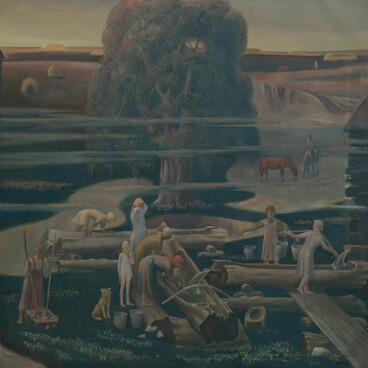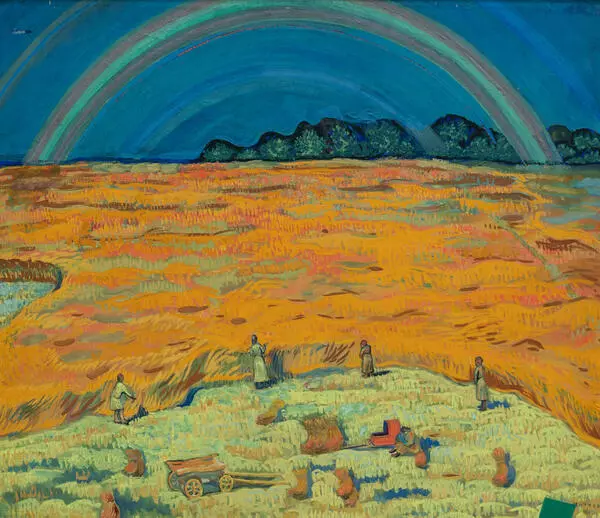In the 1960s, during the Khrushchev Thaw, an interest in Chuvash themes and a need for national identity arose against the backdrop of the general development of Chuvash art. Anatoly Ivanovich Mittov was one of the first artists to express national coloring in art. His works combine Eastern and European cultural traditions, Chuvash pagan background and excellent academic education. The artist studied Chuvash folk art, embroidery, music, and poetry while having a good grasp of Russian and world art.
Anatoly Mittov was born in 1932 in the village of Toburdanovo, Chuvash Republic. He graduated from the Repin Leningrad Institute of Painting, Sculpture and Architecture. He worked as a teacher at the Chuvash State Pedagogical Institute and collaborated with the Chuvash publishing company.
The artist’s works include illustrations for the poem “Narspi” by Konstantin Ivanov, the triptych “The Tale of the Volga”, the series “Forest in Chuvashia”, the series based on the Chuvash folk song “Plow and Harrow”, the series “Chuvash Antiquity”, the easel series of paintings based on “Narspi”, and graphics based on Mišši Śeśpĕl’s poetry.
The Toburdanovo secondary school and a boulevard in Cheboksary were named after Anatoly Mittov.
The Russian art historian Antonina Mordvinova said the following about Anatoly Mittov, “…On the one hand, the artist’s life was full of inspiration and achievements, and on the other, he had to constantly challenge the established art traditions and general inertia in the art sphere, put up with the colleagues depreciating his creative aspirations, as well as battle against poverty and illness. This great number of circumstances both caused and resulted from his short but fruitful life.”
“Wedding” is part of one of the artist’s early large series “The Land of Our Ancestors”. The painting was intended to show the life of the ancient Chuvash, their peasant labor and patriarchal values, ancient rituals and holidays. In these series, the painter strives to express the national coloring with saturation and color contrasts. The canvas format, close to a square, is most often used in this series: the square shape is considered stable and static, which invites contemplation — with it, the artist seems to capture the time and place.
Anatoly Mittov was born in 1932 in the village of Toburdanovo, Chuvash Republic. He graduated from the Repin Leningrad Institute of Painting, Sculpture and Architecture. He worked as a teacher at the Chuvash State Pedagogical Institute and collaborated with the Chuvash publishing company.
The artist’s works include illustrations for the poem “Narspi” by Konstantin Ivanov, the triptych “The Tale of the Volga”, the series “Forest in Chuvashia”, the series based on the Chuvash folk song “Plow and Harrow”, the series “Chuvash Antiquity”, the easel series of paintings based on “Narspi”, and graphics based on Mišši Śeśpĕl’s poetry.
The Toburdanovo secondary school and a boulevard in Cheboksary were named after Anatoly Mittov.
The Russian art historian Antonina Mordvinova said the following about Anatoly Mittov, “…On the one hand, the artist’s life was full of inspiration and achievements, and on the other, he had to constantly challenge the established art traditions and general inertia in the art sphere, put up with the colleagues depreciating his creative aspirations, as well as battle against poverty and illness. This great number of circumstances both caused and resulted from his short but fruitful life.”
“Wedding” is part of one of the artist’s early large series “The Land of Our Ancestors”. The painting was intended to show the life of the ancient Chuvash, their peasant labor and patriarchal values, ancient rituals and holidays. In these series, the painter strives to express the national coloring with saturation and color contrasts. The canvas format, close to a square, is most often used in this series: the square shape is considered stable and static, which invites contemplation — with it, the artist seems to capture the time and place.




